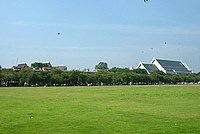- Home
- Rattanakosin
- Royal Ploughing Ceremony
Royal Ploughing Ceremony
the start of a new season
By Eric Lim
The Royal Ploughing Ceremony started off on the morning of 10 May 2007, to mark the new planting season in Thailand. Thousands gathered at Sanam Luang the Royal Field in a ceremony presided over by the HRH Crown Prince Maha Vajiralongkorn.
An ancient Brahmin tradition practiced since the Sukhothai era, the Royal Ploughing Ceremony is eagerly watched in Thailand where almost 50% of the labor force is in agriculture.
With agriculture as its top export, Thailand is one of the five countries in the world that is a net exporter of food.
The rituals are therefore meticulously observed to ensure a rich harvest in the new planting season. The ceremony is held in the sixth lunar month, usually mid-May.
It is believed that in May, just before the full moon, two white oxen pull a gold painted plough, followed by four girls dressed in white who scatter rice seeds from gold and silver baskets.
This is to celebrate Buddha's first moment of enlightenment, which is said to have happened when he was seven years old and had gone with his father to watch the ploughing.
The rice seeds and grains used in the ceremony weigh 2,011 kilograms. Taken from experimental project at Chitralada Palace, the grains were blessed in a grain blessing ceremony held yesterday at the Temple of the Emerald Buddha.
The Ministry of Agriculture will also distribute 10,300 royal sponsored seeds to farmers nationwide to kick off the planting season.
The Phraya Raek Na or Ploughing Lord, the master of ceremonies, usually the Permanent Secretary of the Agriculture Ministry, receives the royal blessings together with the ceremonial ring and staff.
In addition, four single ladies from the same ministry, involved in carrying the rice seeds to be sowed are also blessed.
On the actual day of the Royal Ploughing Ceremony, priests offer the Phraya Raek Na a choice of three lengths of folded loincloth, a ritual meant to predict rainfall.
The shortest piece indicates abundance and the longest, scarcity. What does the year hold in store for the farmers?
The colorful procession commences as attendants in their traditional crimson uniforms lead a pair of sacred royal oxen onto the field. These are rare white oxen specially bred for the ceremony.
The Phraya Raek Na is at the plough accompanied by priests and the four ladies in traditional Thai dresses each carrying the rice seeds in baskets slung at two ends of a pole. Umbrella bearers and musicians follow in their wake.
The ploughing progresses round the ceremonial field to the solemn beat of drums and the wailing of conches as the Phraya Raek Na begins sowing the seeds.
After nine rounds, the royal oxen are unhitched and offered trays with bowls containing seven items - rice and maize, green beans and sesame, hard liquor, water and grass to be fed to the royal oxen.
Based on what the royal oxen choose to eat, predictions are made for the season.
In the Royal Ploughing Ceremony this year the royal oxen chose paddy and maize, a prophecy of abundant harvests and food. The royal oxen also ate grass, a sign of abundant water and a rich harvest. Overall the forecast is extremely favorable for a good year in agriculture. Good news for the farmers.
This is confirmed by the choice of loincloth by the Phraya Raek Na earlier. From his selection, the royal astrologer forecast an abundance of rain and a good harvest.
However, last year the royal oxen chose grass as well. But Thailand last year suffered one of the worst floods in two decades causing severe damage to paddy fields and farms in the central plains.
The ceremony also marks Annual Agriculturists Day, when outstanding farmers are honored with awards for innovations in agriculture.
Farmers from the various provinces were rewarded for their efforts which included the effective use of irrigation, bio-organic principles and micro-organisms in farming.
The official segment of the Royal Ploughing Ceremony ended with the departure of the Crown Prince and members of the royal family.
With the royal departure, the traditional "gold rush" started. Hundreds of eager spectators run on the field to collect the sowed rice seeds as tokens of good luck. The more enterprising can probably sell their rice seeds off at a better price this year!
Tourists may see the Royal Ploughing Ceremony as a colorful spectacle but these rites are held in deep reverence in a predominantly agricultural society where survival is so dependent on the elements.
To return to Rattanakosin.


